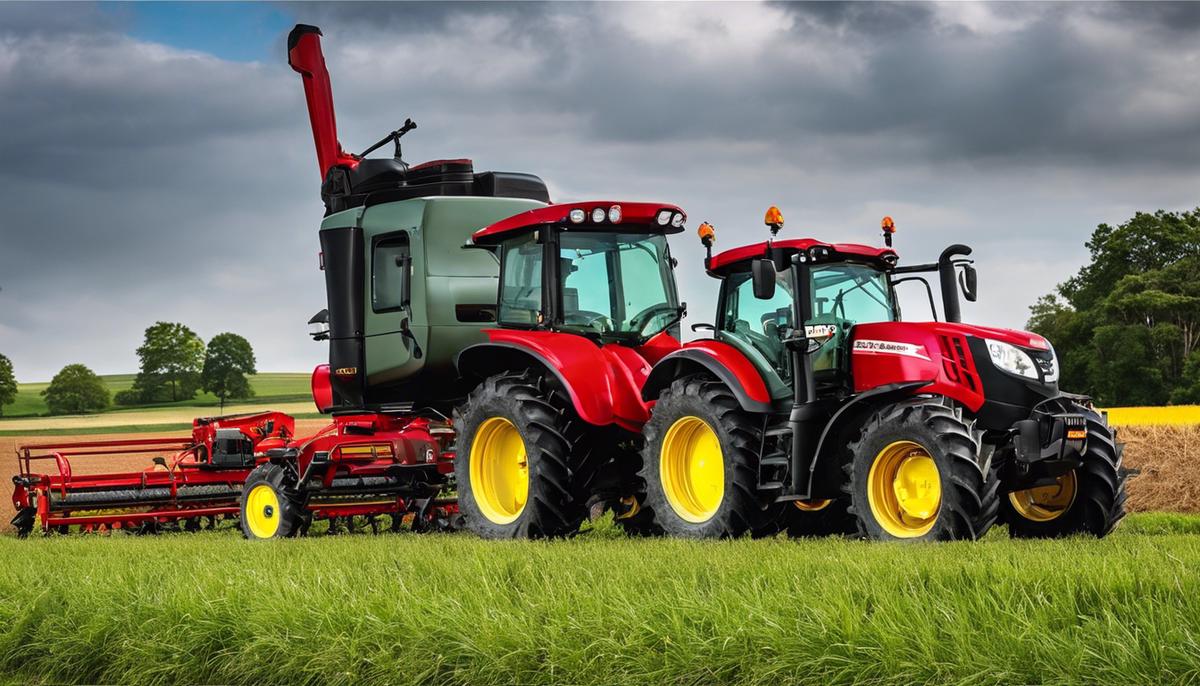

Agridisk
Egypt - Alexandria
.jpeg)
All bout farm implements, Types of Farm implements, and Their Uses
Description: Farming has always been an essential facet of human survival, evolving from simple, rudimentary tools to the innovative and technologically advanced implements we see today. This transformation throughout history reflects the constant pursuit of efficiency and productivity in agriculture. As we delve into the vast sphere of farm implements, we'll explore the ingenious devices that have revolutionized food cultivation and management. From the basic plow that first turned the earth to the intricate sensors that now automate farming tasks, these tools are as diverse as they are essential to the agricultural landscape. Our journey will take us through the types, uses, and care of farm implements, offering an understanding of their pivotal role in shaping the efficiency and sustainability of modern farming. Agricultural enthusiasts and keen hobbyists know that farm implements play a crucial role in cultivating the land and reaping the rewards of a bountiful harvest. These tools of the trade are not just pieces of machinery; they are the workhorses that have evolved alongside human civilization, growing more sophisticated with each passing year. In simplest terms, farm implements are the accessories used in farming to assist with various agricultural tasks. They can range from hand tools like spades and hoes to complex machinery such as tractors and harvesters. They're the gears that keep the farming clock ticking, allowing tasks to be performed more efficiently and with less manual labor than ever before. Historically, early farming equipment was rudimentary. The first farmers worked the soil with sticks and bones. The plow, however, was a game-changer. Its invention revolutionized farming, providing a way to cultivate larger areas of land faster. Initially pulled by humans or oxen, the plow has come a long way. With the advent of the Industrial Revolution, mechanization became the buzzword. Cast iron plows and later, steel plows cut through the soil with greater ease, increasing productivity. This period was notable for the innovation of numerous other farm tools and machinery, taking strides from sheer muscle to steam power. The introduction of the tractor was akin to the arrival of a titan. First, steam-powered and eventually replaced by the internal combustion engine, its multiple uses made it an indispensable part of modern farming. With a tractor, one could plow, till, plant, and more. The efficiency rocketed to unprecedented levels. Fast forward to the present, and farm implements have become marvels of technology. Precision farming is the current frontier where GPS technology guides tractors to within an inch of their target. Implement attachments themselves have become highly specialized – seed drills, cultivators, and various types of harrows (disk, tine, or chain) cater to specific land and crop requirements. Combines, those magnificent beasts that harvest crops, now come with heads specifically designed for particular crops like wheat, corn, or soy. They've become more efficient in separating the grain from the chaff and have minimized waste exponentially. Irrigation has seen a revolutionary shift too, from laborious bucket-and-drip methods to sophisticated drip irrigation systems and center-pivot sprinkler systems, which deliver water directly to the root zones of plants. It conserves water while ensuring crops get the hydration they need. Looking ahead, the horizon for farm implements is one of smart farming, where automation and data analytics blend to create ultra-efficient farming practices. Equipment fitted with sensors can assess soil conditions or crop health and relay this information for precise action, reducing the need for pesticides and fertilizers and further advancing sustainable farming methods. The evolution of farm implements has been, quite literally, groundbreaking. From wooden ploughshares to auto-steer tractors and drones that monitor crop health, the transformation is a testament to human ingenuity. One thing is for sure - as long as there are hobbyists and farmers who cherish the soil, farm implements will continue to evolve, shaping the way the world farms and feeds itself. The Tilling Titans: Disc Harrows and Rototillers As enthusiasts delve deeper into modern farming's dynamic world, the importance of thoroughly preparing the soil can't be overstressed. Key players in this field are the disc harrows and rototillers. These tools break up the soil, chop up unwanted weeds or crop residues, and ensure a primed seedbed for planting. Armed with sharp, rotating discs or tines, they tear through the earth, facilitating better aeration and water infiltration essential for crop growth. The Seed Saviors: Planters and Seed Drills What's sowing without precision? Planters and seed drills are game changers in achieving uniform seed placement. With configurations that cater to a variety of crops, these nifty machines ensure seed is deposited at the correct depth and spacing, maximizing every acre's potential yield. Each seed has the perfect chance to flourish, speaking to the heart of efficiency and productivity. The Nutrient Navigators: Fertilizer Spreaders Farms can't talk, but if they could, they'd sing praises for fertilizer spreaders. Whether you're broadcasting granular fertilizer, spraying liquid nutrients, or injecting anhydrous ammonia, these implements ensure that nutrients are distributed evenly across fields. Their key role is to bolster soil fertility, contributing to the health and vigor of the growing crops. The Pest Protectors: Sprayers Sprayers stand at the vanguard of plant health, providing farmers with a critical tool in managing both pest and disease outbreaks. With technology that ranges from small, handheld units to large, self-propelled sprayers with booms spanning a football field's length, sprayers deliver precisely metered amounts of herbicides, pesticides, and fungicides, protecting crops without undue harm to the environment. The Harvest Heroes: Combines At the climax of the season come the combines— true harvest heroes. These massive machines thresh and separate grain from chaff with seamless efficiency. With the ability to harvest multiple types of crops by simply changing the header, combines epitomize the versatility that modern farming demands. The Ground Guardians: Mulchers and Shredders After harvesting, soil care remains paramount. Mulchers and shredders take center stage, managing crop residues by breaking them down, enriching the soil, and limiting the spread of disease. This act of returning nutrients to the earth and preventing erosion epitomizes the cycle of sustainability that modern farms strive to maintain. These formidable implements underscore the symbiosis of tradition and innovation in agricultural practice. Each has proven indispensable in its own right, helping to meet the world's ever-growing demands while acknowledging the footprint left on the land. With a nod to the past and an eye to the future, modern farming continues to embrace these tools, forging ahead in the endless quest for productivity, sustainability, and harmony with the earth. So you've delved into the riveting world of farming and are now faced with the challenge: How do you choose the right farm implements for your specific needs? With a plethora of options out there, it really boils down to understanding your land, crops, and the goals you have etched in your green thumb. Firstly, consider the size of your farm. It's like picking out shoes; you don't want farm equipment that's too big or small for your acreage. A subcompact tractor might be just right for a small hobby farm, whereas large commercial operations may require more hefty machines. You're aiming for efficiency, not an oversized lawn ornament. Next, think about the type of soil you have and what you plan on doing with it. Tilling needs can vary greatly. If you're facing heavy, compacted soil, a sturdy plow might be necessary. For maintaining the soil without turning it over, perhaps a chisel plow or a cultivator is more fitting. It's all about matching the tool to the task to ensure optimal soil health and productivity. Then, there's the crop conversation. Different crops have different needs – from sowing to harvest. A no-till drill is perfect for direct seeding without disturbing the soil, preserving precious soil structure. Need pinpoint accuracy for planting? Precision planters are where it's at, ensuring each seed's placement is calculated to the letter. For boosting growth, fertilizer spreaders are invaluable. Whether you are spreading granular fertilizer, lime, or compost, make sure to use a spreader that allows for even distribution, avoiding wasteful overlap or missed patches. After all, plants are only as strong as the nutrients they're fed. When pests and diseases come knocking, sprayers step into the ring. From hand-held models for small plots to extensive boom sprayers for vast fields, ensuring the correct dosage and coverage can make all the difference in protecting your crops without harming the environment. And let's not forget the grand finale – harvesting. Your selection here is critical. If you're threshing wheat or combining corn, a properly sized combine reducer harvest losses and maximizes output. The idea is to streamline harvesting while preserving the quality of your yield. Post-harvest soil care often goes overlooked but is pivotal for sustaining land productivity. Implements like stubble cultivators and disc chisels are champions at incorporating crop residue back into the soil, enhancing its fertility and structure for the next planting season. In making these choices, it's essential to meld tradition with innovation. Using tried-and-true methods in conjunction with modern technology ensures that your farm runs optimally while keeping an eye on sustainability. After all, modern farming is a dance between the old and new, cultivating the land for food and future. Choosing farm implements is no trivial task. It requires a blend of practicality, foresight, and a bit of soul-searching on what you want your farm to embody. Whether it's maintaining the vitality of the soil or harvesting the fruits of your labor, each tool has a role to play in the symphony of agriculture. Always remember, the land whispers its needs, and with the right implements, you can answer its call. With an abundance of specialized farm equipment at our disposal, taking proper care of these mechanical marvels is non-negotiable. The health of farm implements directly affects the productivity and smooth functioning of the farm. Let's delve into a few best practices for farm implement maintenance, ensuring their longevity and efficiency. Routine Cleaning: It’s easy to overlook, but adhering to a regular cleaning schedule ensures that your farm implements are free from the buildup of soil, debris, and plant material that can foster rust or harbor pests and diseases. Post-use washing, especially for tillage equipment and planters, not only prevents cross-contamination in fields but also offers an opportunity to inspect for wear or damage. Lubrication Essentials: Moving parts require regular lubrication to function correctly and prevent undue wear. Refer to the manufacturer's guidelines for proper lubrication points and recommended intervals. Using the right type of grease or oil is crucial; the wrong kind can lead to breakdowns or decreased performance. Storage Solutions: Proper storage of farm implements can drastically prolong their service life. Shielding equipment from the elements, particularly rain and snow, should be a priority. Covered storage areas or sheds are investments that protect the metal parts from rust and the rubber and plastic components from UV damage. Sharpness for Cutting Tools: Implements like disc harrows and mowers perform optimally when their cutting components are sharp. Regularly check and sharpen cutting edges to ensure efficiency and clean cuts, which is vital for plant health and disease management. Battery Care: For implements with electrical systems, proper battery maintenance is a must. During off-season storage, disconnect batteries and keep them charged. Equipment that is not used frequently should have the battery status checked periodically to avoid surprises come planting or harvesting season. Hydraulic System Attention: Hydraulics play a key role in many modern farm implements. Regularly check hydraulic fluid levels, look for leaks, and replace worn hoses or seals. Contaminated fluid can wreak havoc on a hydraulic system, so it's essential to keep it clean and topped up. Tire and Pressure Checks: Like any vehicle, farm equipment with pneumatic tires requires pressure checks. Over- or under-inflated tires can affect performance and lead to irregular wear or failure. Check tire pressures according to the manufacturer’s specifications for the type of terrain and workload. Calibration and Adjustment: Precision farming implements, especially planters and harvesters, need periodic calibration to ensure accuracy. Software updates for GPS and data analytics systems are also critical to maintain the efficacy of smart farming technologies. Documentation and Records: Keep detailed records of service schedules, part replacements, and repairs for each piece of farm equipment. This habit creates a useful reference for troubleshooting, reselling, or simply maintaining a regular maintenance routine. Professional Servicing: Some maintenance tasks require specialized knowledge or equipment. Don't hesitate to use professional services for complex repairs or when you encounter an issue beyond the scope of a trusty toolbox. Staying ahead of potential mechanical failures can often save time and resources in the long run. Understanding that these machines are the backbone of today’s agricultural success, taking proper care of farm implements translates to a well-tuned farm operation. Implementing these best practices is more than a series of chores; it's an investment in the farm's future. As hobbyists delve deeper into farming, staying abreast of the latest innovations in farm equipment technology is both exhilarating and essential. Today's advancements are not just a matter of bigger and better machinery; they're also about smarter and more sustainable practices that benefit the soil, the crops, and the farmer's bottom line. Robotic technologies are cutting a swathe in the world of agriculture. Autonomous tractors, guided by GPS and sensors, can now till, plant, and harvest with minimal human intervention. These smart machines can operate around the clock, increasing productivity while allowing farmers to focus on more strategic tasks. Robotic arms, capable of delicately handling fruits and veggies, promise to revolutionize picking processes that were traditionally labor-intensive and time-restrictive. Drones, or unmanned aerial vehicles (UAVs), have taken to the skies above farms, providing a bird’s-eye view that was once impossible or prohibitively expensive. Drones equipped with advanced cameras and sensors can monitor crop health, track livestock, and even assess water levels. They can quickly pinpoint issues like nutrient deficiencies, water stress, or pest invasions and enable precise action, thereby conserving resources and safeguarding yields. Artificial Intelligence (AI) is changing the landscape — quite literally. Beyond mere data collection, AI systems can analyze and predict farm conditions based on the immense amount of data they gather. This predictive capability allows farmers to preempt issues by making informed decisions about planting, watering, and harvesting times, all tailored to specific plots of land. Mimicking nature, engineers are developing bio-inspired machinery that works in harmony with the environment. For example, innovations include robotic root systems that penetrate the soil to aerate it and deliver water and nutrients directly to plant roots. Such inventions mitigate soil compaction and water waste, ensuring a healthier ecosystem. On the microscopic level, nano-technology is beginning to infiltrate farming tools. Nano-coatings can protect equipment from corrosion, wear, and bio-fouling, extending their lifespan and efficiency. Nano-sensors, integrated into farm tools, can detect chemical signatures in the soil, offering precise readings of pH levels, moisture content, and other critical parameters. As sustainability becomes increasingly vital, the shift to electric and hybrid farm equipment is gaining momentum. These clean energy solutions reduce the carbon footprint and operating costs, with the added benefit of lower noise and fewer vibrations, which makes them more comfortable for user and livestock alike. The latest farm machinery comes equipped with on-board diagnostics and telematics systems. These technologies provide real-time insights into the equipment's performance and health, facilitating prompt maintenance and averting costly downtimes. Farmers can access this data via smartphones or computers, keeping them connected with their machinery’s status at all times. The leap in equipment technology is not only elevating productivity but also fostering a more intimate understanding of the land and processes. This technological renaissance in farming equipment manifests the perfect blend between innovation and our ever-green passion for agriculture. As enthusiasts seeking to cultivate our knowledge and our fields, staying informed of these advancements helps sow the seeds for a thriving, sustainable future. With the relentless pace of innovation driving the future of agriculture, farm implements continue to evolve, bringing precision and sustainability to the forefront of farming practices. From the basic mechanical wonders that began the mechanization of agriculture to the sophisticated, computerized systems paving the way for the next generation of farmers, our exploration underscores the importance of these tools in ensuring a well-fed world. Understanding the roles, selection criteria, maintenance, and technological advancements of farm implements equips us with the knowledge to appreciate and engage with the fabric of agricultural success. As the agricultural landscape grows ever more complex, the mastery of these implements remains a testament to humankind's ingenuity and an essential key to unlocking the full potential of our vital relationship with the land. Farming is a fundamental venture that forms the bedrock of human survival and civilization. Introduction of machinery into the agricultural sector revolutionized practices, improved productivity, and considerably eased the labor. This discourse dives deep into the world of farming implements, from the basics to their application, technological advancements, and maintenance. From the humble plow to complex GPS-controlled machinery and drones, Farming has indeed come a long way. Farmers and enthusiasts alike stand to gain a wealth of understanding from the following detailed overview of these important tools. Are you at the threshold of beginning an agricultural adventure, or have you always wondered about those peculiar tools used in farming? We're pulling back the veil to shed light on farm implements; devices synonymous with the transformative journey of a barren field to a lush countryside. Farm implements are the unsung heroes of rural life, efficiently transforming hard, exhaustive labor into manageable tasks. They consist of a varied assortment of tools and machinery, each designed to fulfill a specific role in the farming sequence, starting from soil preparation to harvest and beyond. Recognized as one of the fundamental farming implements, the Plow takes center stage in soil preparation. Its job is to break and turn the soil, creating a loose layer that's easier to work on. It often comes in different types, including moldboard, chisel, and disk types, each designed for different soil conditions and cropping systems. Cultivators follow suit after the Plow has done its job. With their curious arrays of metal teeth, they work meticulously, stirring and pulverizing soil – preparing beds for planting. Cultivators crucially help in managing weed growth and blending soil amendments. Seeders are the designated diplomats of the farming world because they effectively bridge the gap between barren land and bountiful harvest. Their role? Simple. As their name suggests, Seeders are responsible for evenly distributing seeds over the field. They range from manual hand-held styles to larger, tractor-driven devices which ensure uniform seed spacing, depth, and soil coverage. After planting, it’s all about maintenance, and here is where Sprayers come into the picture. These handy tools ensure the crops get essential nutrients through fertilizers and are protected from pests. Sprayers might seem inconsequential but hold an important role in farming, both on a small scale or expansive commercial setups. Next up, are the Harvesters. These are the giants of the agricultural field, literally and figuratively. These implements are designed to reap and thresh grains on a large scale, marking the culmination of a cycle of growth. From combine harvesters to specialized corn or potato harvesters, these machines make light work of what might otherwise be an incredibly labor-intensive process. Finally, we tackle the balers and loaders, the handling and storage specialists. These machines facilitate easy storage, transport, and sale of hay, grain, and other farm outputs, playing their part in keeping the wheels of the agriculture industry turning. Of course, this is not an exhaustive list. The world of farming is vast, and the tools involved are just as diverse. Each implement serves an integral purpose, and many of them can be multi-functional, depending on the demands of the farm. These tools do not merely make work easier; they're the lifeblood of modern agriculture, pivotal in sustaining the global food supply. Indeed, understanding farm implements is akin to deciphering the beautiful, cyclical narrative of farming. Behind every crunchy apple, each sheaf of wheat, and all the vegetables in your salad, there's a symphony of these implements performing at their peak. Every bite is but a testament to their marvelous work. Happy Farming! Farm implements, the unsung heroes of the agricultural world, play pivotal roles that often elicit a newfound appreciation for providing food to billions. Diving deeper into these essential farming tools allows us to explore the workings of the land in all its glory. Overwhelming? Yes, but that's where plows, cultivators, seeders, sprayers, harvesters, balers, and loaders save the day. From basic turning operations to more intricate tasks like aerating and pulverizing soil, and managing weeds, these instruments are the true unsung heroes of the farming world. They ensure seeds find their perfect spots in the soil - not too deep nor too shallow, just right. Coupled with the sprayer's shielding effect against pests and diseases whilst supplementing nutrients, they form a formidable team in crop development. These Herculean machines are symbols of culmination, reaping ready crops and threshing grains. Unsurprisingly, diversity is their strength as different harvesters cater to the plethora of crops that grace our fields. From combine harvesters for grain crops to corn pickers for corn harvesting, these titans in the field ensure the hard labor of the past months bear fruit. These backbones of the field gather and tie up loose stalks, leaves, and other remnants into neat, manageable bundles or bales. Loaders, then, hustle to transport these bales, whether for storage or sale. The farming world would come to a standstill without these tools. Each implement is designed with a unique task in mind, yet they all contribute to the unified goal of sustaining the monumental global food supply. One cannot overstate the impact and vitality of these tools in the world of farming and beyond. So the next time you find yourself diving into a hearty meal, take a moment to appreciate the unsung heroes of the farming world - those trusty farm implements that toil away silently behind the scenes, ensuring that food reaches our tables season after season. Now, let's delve headfirst into the amazing world of high-tech farming tools! The introduction of digital technology into farming has truly transformed the face of agriculture and has reinvented the way farm implements are used today. GPS technology now controls and guides most modern farm equipment. This allows farm work to be done with remarkable accuracy. For instance, the seeding process, which previously required farmers to eyeball and guess where the seeds were going, is now streamlined by precision seeding technology. GPS systems guide the seeders to ensure that seeds are evenly distributed along the row with exact spacing, which leads to unified growth and improved crop yield. Digital weather stations are another example of technological innovation in agriculture. By constantly monitoring weather conditions such as temperature, rainfall, and wind speed, farmers can plan their activities around the weather. This definitely takes the guesswork out of when to deploy certain implements, such as the sprayer to protect crops from pests, or the harvester to reap the grains at the right time. Technology also plays a vital part in soil analysis. Advanced soil sensors are utilized to measure the moisture content, nutrient levels, and pH level in the soil. This information is significant in determining the best time to till the soil and the right amount of fertilizer required, thereby making the use of plows and other soil management implements even more efficient. In the yesteryears, baling and loading were labour intensive tasks that took up a huge chunk of a farmer's time. Not so in our modern farming landscape! Today, thanks to automated technology, balers and loaders can operate with minimal supervision. Moreover, advancements in technology have given rise to round balers, which produce round bales that are simpler to store and transport, saving farmers much-needed time and resources. Robotic technology is also a game-changer in the farming world, assisting in keeping livestock in check, monitoring crops and managing weed control. This doesn't mean that they replace the need for cultivators, harvesters, and sprayers, but rather, they enhance the usage of these implements, enabling them to be put to work with increased accuracy and efficiency. To cut the long story short, technology has definitely given agricultural implements a digital makeover. In the scope of this rapidly changing world, farmers are keeping pace by adopting these technological advancements. All these innovations are tailored to make farming easier, efficient and rewarding, not just for the farmer, but also for the globe in terms of securing the food supply chain. So, let's appreciate these ingenious transformations that are shaping the future of agriculture. The world of farming implements is truly a fascinating one, isn't it? Ensuring the Maintenance and Safety of Farm Implements Farming machinery and implements, just like devices in any other field, are subject to wear and tear. Without regular maintenance and care, these tools might not last long or perform optimally. Here are some tips to keep these indispensable tools in durable and safe working order. Regular Cleaning The first step in farm implement maintenance is thorough cleaning. Soil, debris, dust, and plant residues left on the equipment can accelerate rusting and degrade its quality. Therefore, it's crucial to clean each part meticulously after every use. Use a pressure washer if needed for tougher dirt removal. Lubrication is Key Farm implements come with numerous moving parts. Over time, these parts may experience friction, leading to degradation. Regular lubrication is crucial to ensure smooth operation and elongate the lifetime of the tool. Always refer to the manufacturer's guide, as each machine might require a specific type of lubricant. Regular Check-ups A routine check-up allows one to identify any potential issues before it escalates into a significant problem. For instance, regular inspection of the tires' pressure can prevent accidental punctures and maximize performance. Additionally, always check for loose bolts, worn out belts, or signs of unusual wear on the implements. Repair or Replace Damaged Parts Even with the best maintenance regime, damage can occur to these machines. Always replace or repair any damaged part as soon as it's identified. Neglecting even minor damages can cause major breakdowns or accidents in the future. Proper Storage Exposure to harsh weather conditions could hasten the degradation of farm implements. It's essential to have a proper storage facility, such as a shed or a garage, to protect the equipment. Besides, keeping the implements indoors prevents inadvertent injuries that might occur if children or animals come into contact with them. Safety Measures Always prioritize safety when operating these machines. Some safety measures include wearing appropriate personal protective equipment, understanding the operation manual to avoid misuse, and maintaining a safe distance when the machinery is in operation. Advancements in Tech for Easy Maintenance Moreover, technology's transformative impact on farming extends to maintenance and safety aspects as well. For instance, 'Smart Maintenance' systems can monitor the condition of the implements, schedule maintenance needed, and even order replacement parts automatically. These systems, incorporated into farming equipment, reduce the time, effort, and potential errors associated with manual monitoring. Adopting these practices into your farm implement maintenance routine can go a long way in reducing costs related to repairs and replacements. Well-maintained and safe equipment enhances efficiency, resulting in a more productive and rewarding farming experience. The world of farm implements is undoubtedly vast and intriguing. Knowledge of these tools, their operation, and their application is invaluable in navigating the field of farming. Furthermore, advancements in technology will continue to redefine farming, bringing about increasingly efficient, convenient, and productive methods. However, as we embrace these changes, understanding the importance of regular maintenance and rigid safety protocols must shoulder equal importance. In essence, farming's future is promising—it's a blend of age-old practices, modern technology, and crucial backgrounds of safety and maintenance.All bout farm implements, Types of Farm implements, and Their Uses
All bout farm implements
Introduction to Farm Implements
Farm Implements – The Backbone of Agriculture Through Time
The Basics: What Are Farm Implements?
The Evolution of Farm Implements
Today's Farm Implements
The Future of Farm Implements

Types of Farm Implements
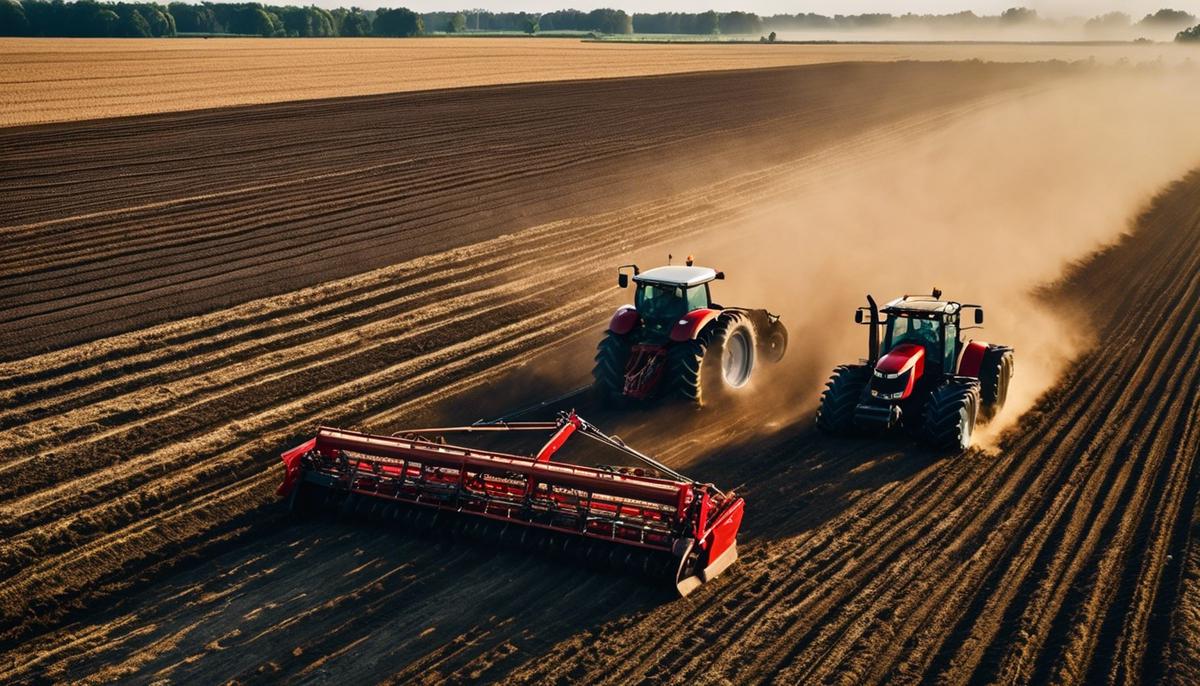
Selecting the Right Farm Implements
Selecting the Ideal Farm Tools for Your Agricultural Needs

Maintaining Farm Implements
Maintaining Your Farm Implements: Best Practices for Longevity and Efficiency
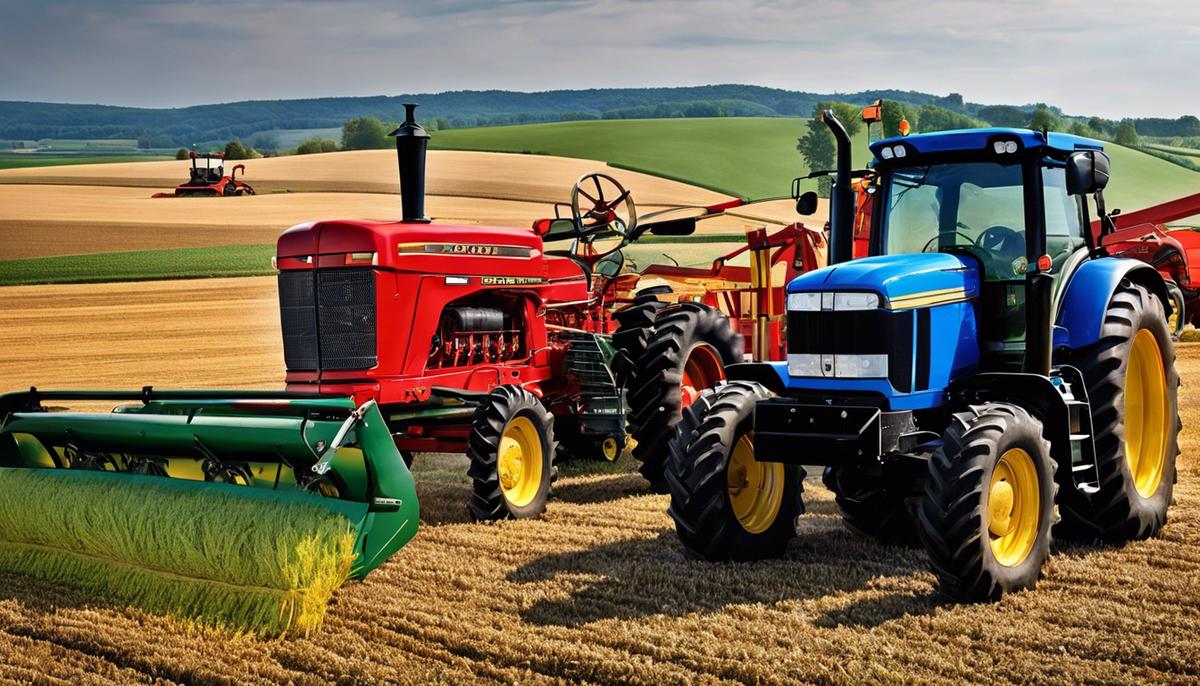
Innovations in Farming Equipment
Robotics in Agriculture
Drone Technology
AI-Powered Analytics
Bio-Inspired Machines
Nano-Technology in Farm Equipment
Electric and Hybrid Solutions
On-Board Diagnostics and Telematics
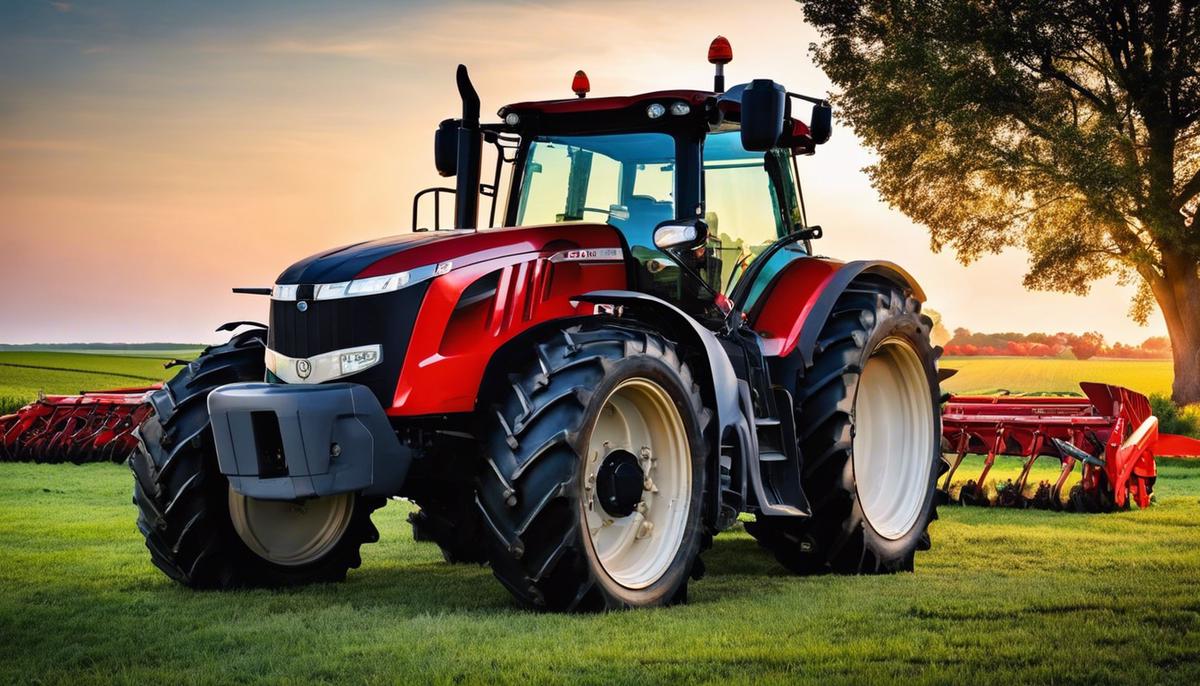
Farm implements and their uses
The basics of farm implements
Making Headway in Farmland: Unpacking Farm Implements for the Greenhorns
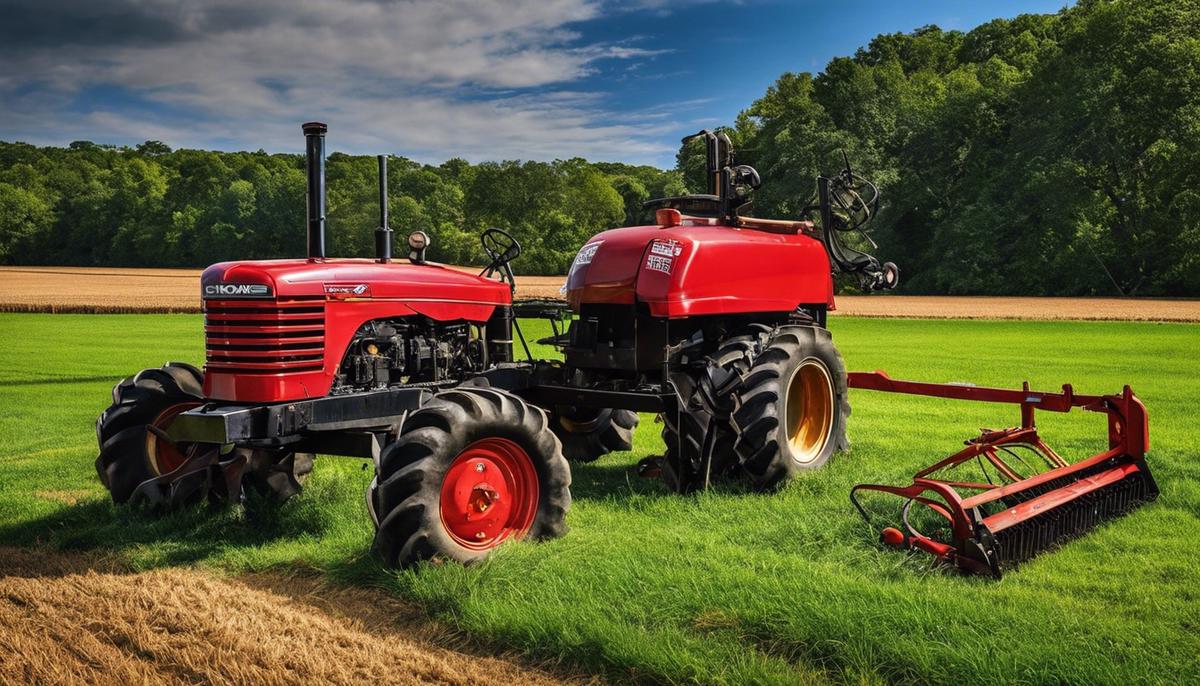
The application of farm implements
Taking a deeper plunge in the world of agriculture and farming is a journey filled with discovery.
Imagine for a moment, trudging through fields with giant tractors and other bulky machinery to manually do the jobs these tools do tirelessly.
Having covered plows and cultivators, an unrivaled appreciation surfaces for their crucial role in soil endeavor.
Next in line, seeders star at playing the vital role in nurturing new life on farms.
As harvest season rolls around, harvesters take center stage.
Post-harvest, balers and loaders work in tandem to efficiently handle and store farm outputs.
Although diverse in their design and functionality, these farm implements share a common theme - indispensability.
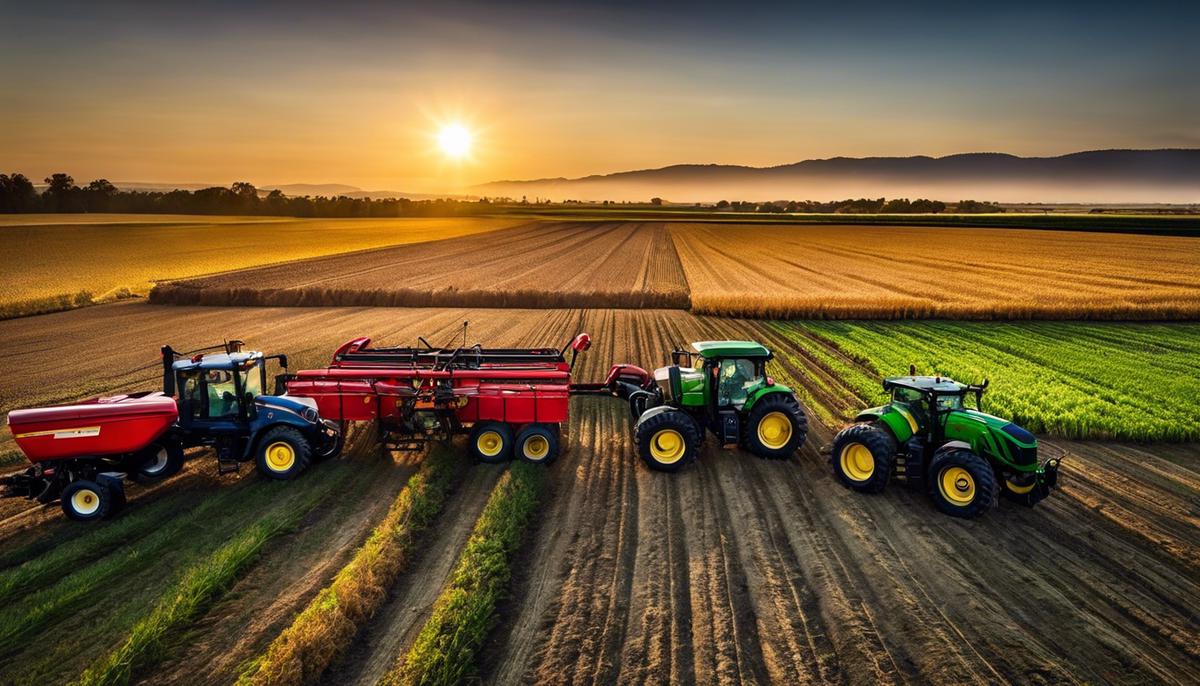
Technological advancement in farm implements
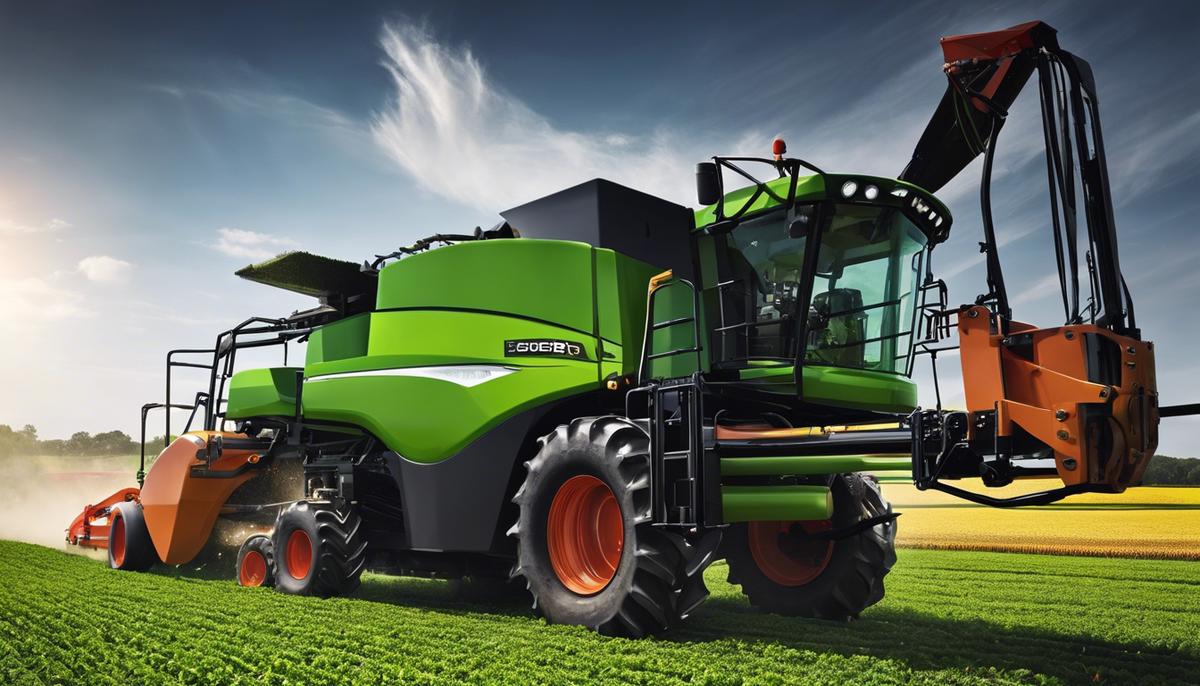
Maintenance and safety of farm implements
